How-To: Enduro Racing
Whether you’re having a crack at a Transmoto event or racing your first serious enduro, you’re going to encounter a broad mix of terrain and obstacles. So, to help you approach race day with confidence, here’s some sage advice from multiple national off-road champ, Chris Hollis.
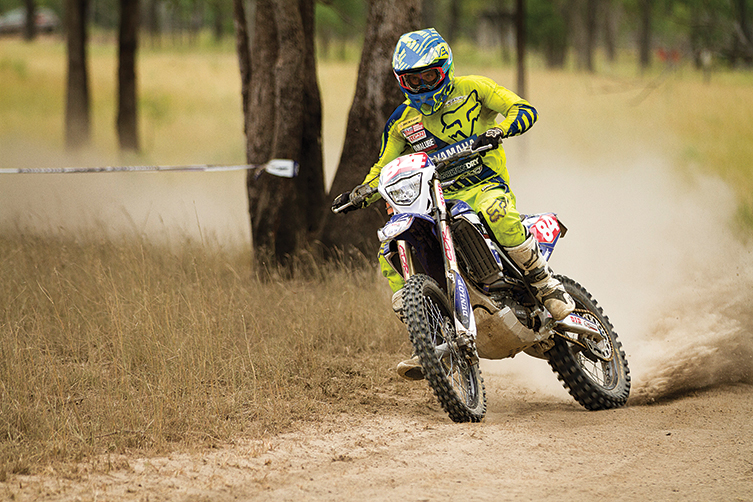
HARDPACK
Mental Approach
To be successful on hardpack, your mental approach needs to be the same each and every time – you should focus on carrying momentum, remaining smooth and minimising mistakes. And you should even apply those key points when practicing in hard terrain. For me, the key to riding hard terrain well is setting up early for corners, as this allows you enough time to be patient. Hardpack involves a never-ending search for every skerrick of extra traction you can find, and I am always looking to avoid the slickest areas. It’s also very important to get your hard braking done in a straight line before you tip the bike over too far on the way into corners. From there on, the name of the game is momentum. As with any corner or obstacle you encounter on a motorcycle, your vision should be focused well ahead – toward the corner exit or the next obstacle on the track.
Body Position
When traction is at a premium on hardpack, it’s preferable to come in a little faster and coast through the corner, rather than trying to get on the throttle really hard to build speed in the middle of the corner. As the photo on this page demonstrates, my body position is quite upright on the bike because this sweeping right-hander was very hardpacked underneath with loose bull dust on top. There was barely any traction, so I couldn’t really tip the bike over through the corner. By keeping an upright position, I’m getting the most out of my tyres’ ability to ‘bite’ into the ground (and it’s definitely important to use the right tyre for the job in this terrain – I run Dunlop’s intermediate-hardpack option, the Geomax MX52). Besides sitting upright on the bike, I also find the best position is a neutral one – not too far forward or back in the seat – as this will allow you to transfer your weight on the pegs through the balls of your feet, to gain the most traction.
Controls
Being smooth is the absolute number one priority with hardpack terrain. This involves all aspects of controls use – from braking through to clutch use and throttle control. When braking on hardpack, traction is limited. Therefore it is essential to get it done in a straight line and early. Your braking on this type of terrain should be mainly done through the front wheel – I would estimate that the perfect mix is nearly 90 percent front and 10 percent rear brake. Also, something a lot of people underestimate (or forget to use) on hardpack is engine braking. I will shift down a gear earlier than I normally would and let the engine aid me with braking. This also stops the unsettling ‘chattering’ sensation you often see riders experience on hardpack.
Once braking is out of the way, it’s important to maintain momentum. I will usually carry speed with no throttle through part of the corner before gradually rolling on the gas. If you’re using the clutch, it should be done to keep the power smooth, and not to build the revs quickly or get to full throttle. Any time you slide, you’re losing traction and speed, so be patient and remember that momentum is your best friend here.
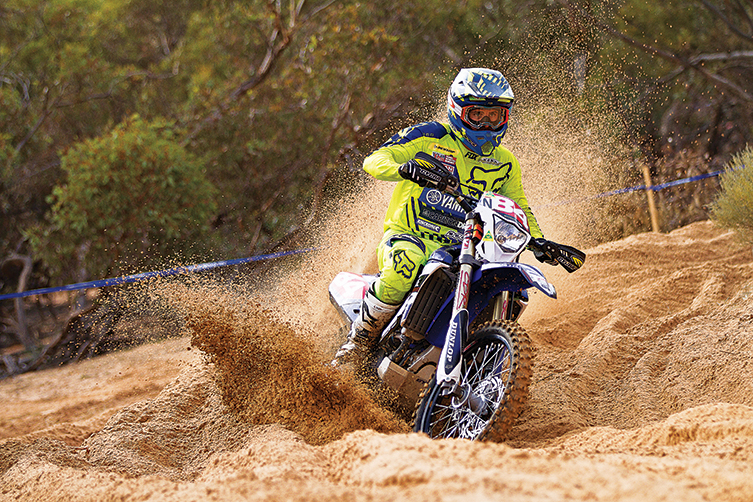
SOFT TERRAIN
Soft Ruts
Softer tracks tend to have bigger braking and acceleration bumps and generally form better, deeper ruts. And as the track constantly changes, you need to be adaptable. My key to soft ruts is entering them a little bit slower. This allows me to properly get into the rut. If you come in too quickly, it can cause you to stand the bike up or completely pop out of the rut and stuff the corner. I carry momentum through the mid-section of the corner with little to no throttle, and then get on the gas pretty hard as I exit. Keep your inside leg and foot up to avoid catching it and losing time or, worse, causing an injury. With soft ruts, you have something to lean into and plenty of traction, so you can usually be aggressive with the throttle on the exit and build speed quickly. Soft terrain will often mean you’re heading straight into acceleration bumps once you exit, so it’s important to nail your corners.
Body Position
I can’t overstate how important vision is when encountering ruts – because where your eyes go, your body and bike will follow. You should have already chosen your rut before you begin braking, and be looking ahead past the midpoint and towards the exit of the corner. Once you’re in the rut, your eyes should then have spotted your exit, and be looking towards the next obstacle or section of track.
In soft terrain – whether it is a rut, or a loamy flat corner or a sandy berm – you have traction to work with, so your body position needs to be adjusted accordingly. You need to lean more with the bike to get the traction to the ground. Again, use your outside foot and legs to grip the bike tightly and force your weight through the pegs.
Controls
With soft terrain comes traction, and with traction comes the ability to be a little more aggressive with your controls. Braking can be done harder and later, so use this to your advantage by making up time (or making passes) under brakes. A great practice drill is just sitting a cone near a corner and trying to hold the throttle on until you pass it, then transition to brakes. Keep moving the cone further towards the corner as you improve. With the throttle, you can definitely be more aggressive; it’s just important to know when to be smooth and when to go hard. Carrying momentum is still the most important thing, but once you are able to lean into the rut or corner, it’s time to crack her open and get moving for a fast, explosive exit
Sand
Sand is a funny one, as it can suit riders without as much technical ability – and those with no fear! If you can hold the power on, you can be successful in sand. However, that does come with risks. You need to stay off the brakes as much as possible in sand. When coming into corners, I don’t back off the throttle completely as this prevents my fork from diving too much. I let the engine braking and the sand itself do the work in slowing me down. Again, it’s key to carry momentum and get back on the gas as early as possible. It’s very similar to riding a jet ski, in that you need to be on the throttle to turn the thing. If you apply this to sand, you will improve quickly. Also, try to stand as much as possible. Your legs are like another set of shock absorbers. And in sand, you need two sets of suspension, not one!
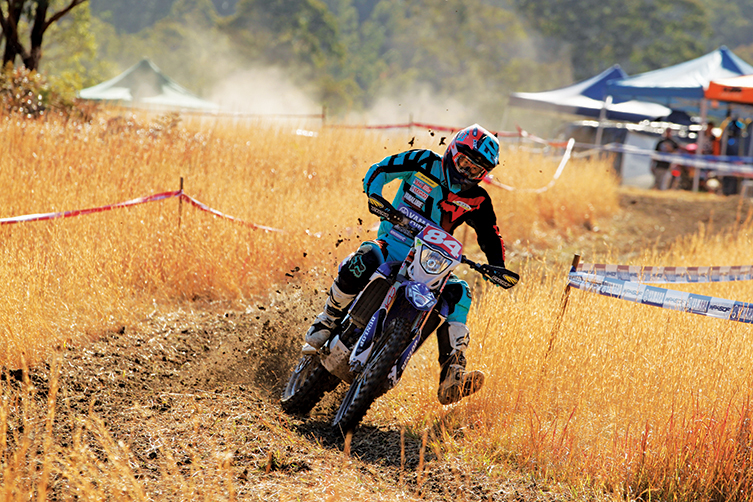
LINE SELECTION
Give Yourself Options
It’s always important to give yourself options. This means getting your braking done earlier and keeping your vision focused ahead so that you are able to spot any improving lines. As you can see in the three-photo sequence above, I am hard on the brakes early, the bike is squatting down and I’ve moved to the seated position for corner entry. I’m sitting quite upright as I tip the bike into the corner, with my foot still out and up to balance and to load weight onto the front tyre. This allows me to use the side knobs of the tyre in that soft dirt. I’ve kept it in the main line here as it’s not too rough and offers good traction. In the third photo, I’m starting to tip in, look ahead and targeting where I want to start rolling the throttle on.
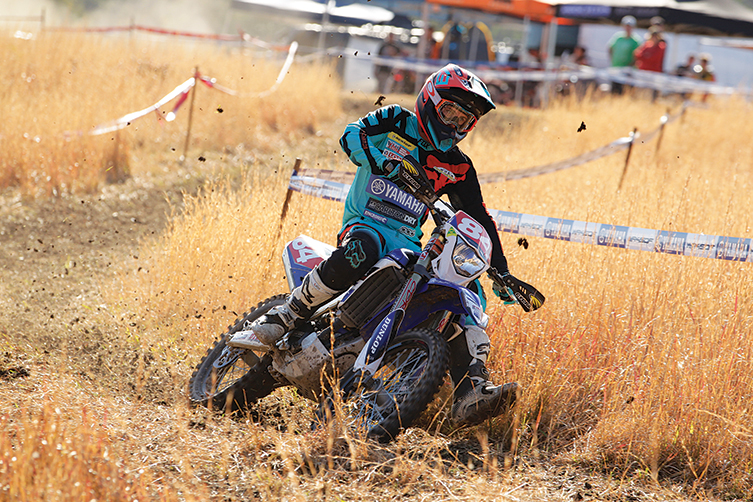
Be Creative
Be mindful that the main line is not always the best or fastest option, especially as it becomes worn and rough. On hardpack, look to avoid slick spots and the blue-groove if possible. Search for any edge, small rut or bit of traction to help you stay planted and carry speed.
On softer terrain, you need to spot the best rut and/or traction. Look for the moist dirt (as seen in the photo of me turning left up the hill, where I’m close to the outside edge of the track, but that’s allowed me to find traction and maintain speed). Finally, in sand, be creative. Sand allows you to hold it pinned and even make your own lines. It changes lap-to-lap, so remain mentally and physically ‘fluid’ on the bike and ready to change your plan at any moment.
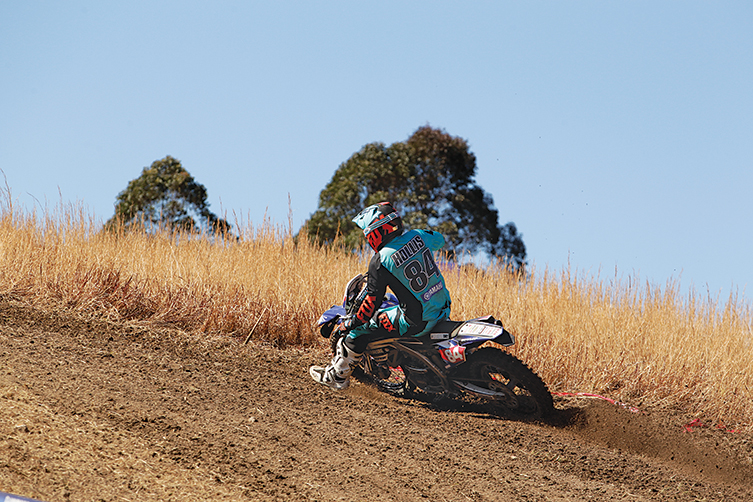
Adapt to the Track
On a race track that sees lots of traffic at full noise, what works in the morning doesn’t usually work in the afternoon. Things change on all types of surfaces and you need to be able to adapt. The key to this is having an open mind and looking for opportunities. Although taking the far outside line might mean a longer path, it will often become an advantage if it saves you energy and means you’ll get more traction. Look for developing ruts and opportunities to avoid braking or acceleration bumps, and you will save big chunks of time on riders who don’t adapt to what’s in front of them.
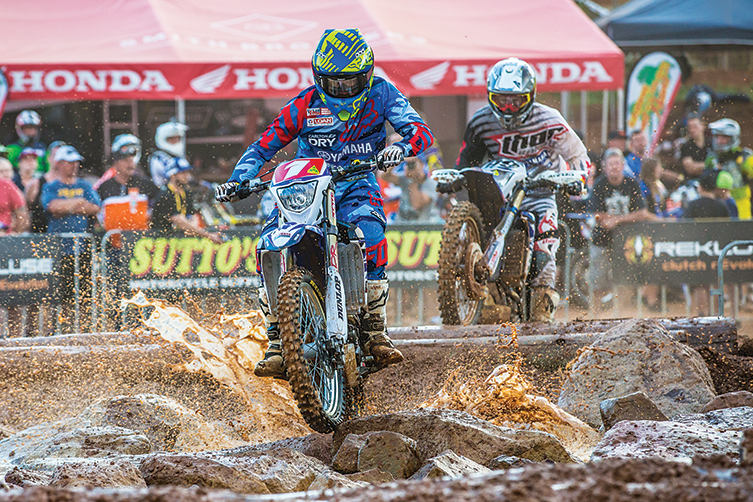
TECH TERRAIN
Mental Approach
Confidence is really important for technical terrain. Whether it’s logs, water crossings or rocks, the best way to improve and gain confidence is to practice. A lot! Keeping calm is also a key to being successful through technical stuff. It’s super-easy to get out of shape on a river crossing or over a log, and you need to remain calm and be able to use your skills and controls to get out of the situation cleanly. Plan ahead as you approach a technical section, choose an entry speed and gear, and then stick to it. And be ready to adjust on the fly.
Controls
Your mental approach will only get you so far, and at the end of the day, it comes down to your throttle, brake and clutch control. For example, if you come up to a large log on a trail and just chuck a big wheelie into it, the rear wheel will hit the log and throw the front-end down, resulting in you going over the bars. You need to control the clutch and pop the front wheel up, just touching the log (we call this a wheel tap), and then drive over the log with your rear wheel without blasting the throttle wide open. Getting this right on larger logs takes lots of practice and persistence.
Water Crossings
As seen in the photo on this page, I am nearly in the full attack position, standing up and allowing my bike to work underneath me, with my eyes focused on the exit – that is, beyond the rocks. This applies to all water crossings, no matter how big the rocks are. You need to look ahead, be calm and use your legs as an extra set of suspension. If you are too aggressive on wet rocks, you will spin, lose traction and go down. You need to come into the section with some momentum and then be steady on the throttle throughout. Don’t look to build speed during the crossing. Just use the torque of the engine and then get on the gas once clear of the obstacle.
About The Rider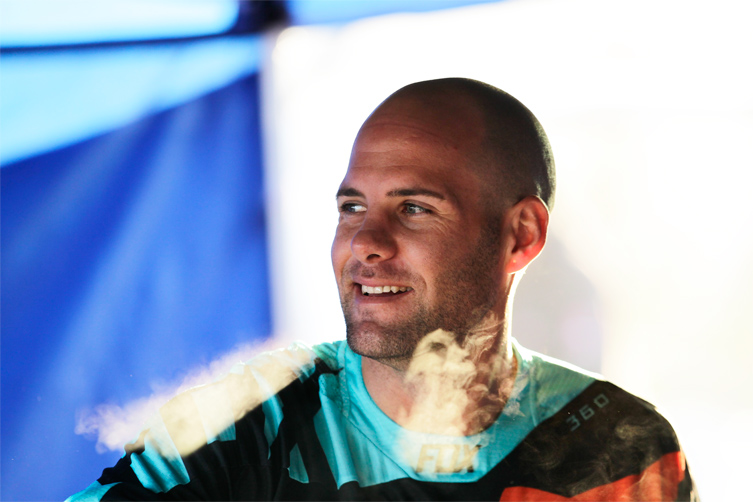
Chris Hollis is a legend in the enduro scene, who currently rides for the CDR Yamaha Off-Road Racing team and is based out of Byron Bay in NSW. Hollis has done it all on a dirt bike – he’s won two Outright AORC titles, represented Australia at the ISDE, won A4DE and Enduro-X titles on multiple occasions, and even raced for Husqvarna’s factory EWC team in Europe. And so far this season, the 31-year-old has finished second in the AORC’s E2 class, and third Outright. All of which means the man is well placed to dish out expert advice on all the different facets of enduro. Take his recommendations on board and you’re sure to improve your abilities … and crash less!
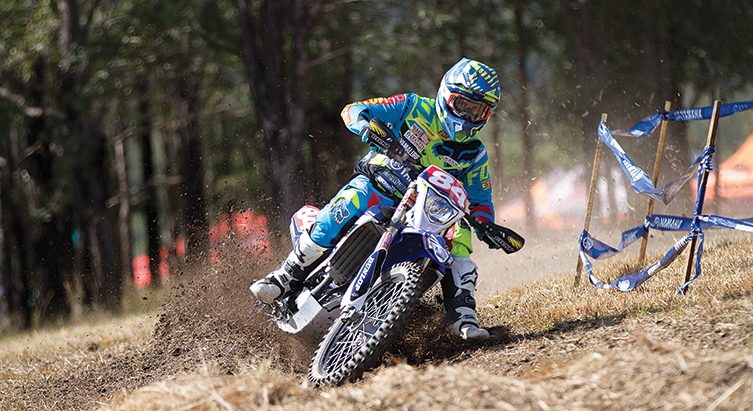







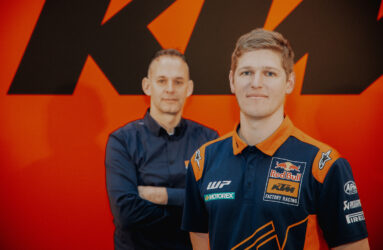
Be the first to comment...